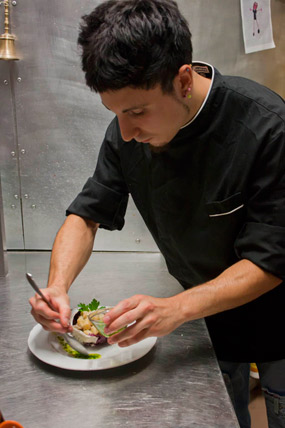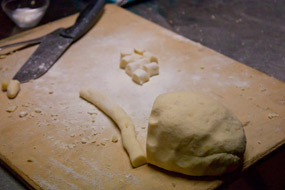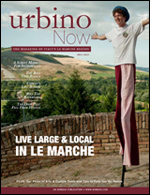In small cities and large, aficionados of Italian cuisine are taking steps to stop the slow disappearance of fresh pasta from the nation’s tables.
URBINO, Italy – Andrea Maioca begins his work day by laying out flour in a concave circle on a wooden board. With the addition of only water and eggs he is prepared to carry on an Italian culinary tradition: making pasta.
“Pasta making is the first thing every Italian should know because it is in the Italian soul,” he said with conviction.
For more than a thousand years, Italian hands have mixed and molded these few simple ingredients into this primary staple of their cuisine.

25-year-old chef, Andrea Maioca, has been working at La Balestra restaurant professionally for about 1 year. He learned how to make pasta when he was a teen and has loved making it ever since. He loves his job and wants to be a chef for the rest of his life.
But over the last few years, a battle for the soul Italian cuisine has begun: homemade pasta is getting harder to find. For example, this famed Renaissance city lost its last pasta fresca (fresh pasta) shop this year. Today, Urbino residents can only obtain fresh pasta by making it at home or from a restaurant that prepares its own. Even that is becoming a rarity: According to Elavil Sisti, co-owner of Urbino’s Antica Osteria “da la Stella” restaurant, an estimated 80 percent of in-town restaurants do not make their own pasta, but instead buy it from the market.
And experts on Italian cuisine, like Daniela Storoni, art director of a Renaissance cuisine organization here called Il Piatto del Duca, said the changes in Urbino reflect a slow but growing trend across the country.
“Many young people don’t know how to make it,” she said, adding “È un arte! (It’s an art!). It is not possible to do without training.” For this reason, she pointed out, Il Piatto del Duca has made food clinics available to the public hoping they will learn about the practice of pasta making, as well as its place in Italian history.
It’s a colorful history. According to Burton Anderson, author of The Foods of Italy, Italians and pasta have been linked since Arab forces invaded Southern Italy in 652 AD. That contradicts the popular story that Marco Polo introduced pasta into Italy in 1296 on his return to Venice from China. This misconception, food historians say, stems from the fact that “pasta” was developed in China and Italy independent of one another.
The authors of Pasta: the Story of a Universal Food explain that although noodles from both countries seem identical on a superficial level, they are fundamentally different. Italian pasta, as most pasta is today, is made from durum wheat. This grain is native to Italy, but it doesn’t grow naturally in China, where “pasta” is made from another cereal grass, millet.
In The Encyclopedia of Pasta, leading Italian food historian, Oretta Zanini De Vita, said that by the time Marco returned, people throughout Italy had been eating pasta for at least a century.
Storoni shared with participants of one of Il Piatto del Duca’s food laboratories that in the time of the Renaissance noblemen flaunted their wealth and power through elaborate food banquets that would last through the night and the following day. In this era, the poor ate pasta only on Sundays in a soup and the wealthy – who made their pasta with eggs instead of water to show status – ate pasta every day.
Storoni said pasta is still important in Italian cuisine – “as necessary to Italian cooking as showering is necessary to get ready in the morning” – but more Italians today purchase their pasta from the supermarket. Storoni tracks that trend to the societal changes that started in the 60s and 70s which have seen Italy’s women moving from the home to the workforce, leaving less time for home-cooking.
For decades, pasta fresca shops were as ubiquitous in Italy as pastry shops in France. Customers ordered pasta in the morning, and picked it up on the way home from work before pranza – lunch – which is the main meal of their day. But even then, many homemakers made pasta at home.
We were the best chefs in the world, but now we are losing that label.
Both of these traditions, however, have begun a downhill slide in Urbino in the last few years. Packaged prepared foods as a result of consumerism and prosperity have obscured these ancient roots of Italy’s gastronomic culture. The tradition of pasta making by hand is still alive, but it is undoubtedly less common than it used to be. Storoni was pleased to note that in recent years young people have become curious about rediscovering old traditions, including making pasta.
One of those young people is Andrea Maioca, a 25-year-old chef who prepares fresh pasta for a small restaurant, La Balestra, in Urbino. Maioca learned how to make pasta from his mother and has been practicing since he was 15 years old. He loves to cook and he wants to be a chef for the rest of his life. He tried to use all local ingredients in a menu that features traditional cuisine of the local region, le Marche (pronounced Mah-Kay). He intends to teach his children how to prepare handmade pasta, as well as cuisine from around the world because, he says, “it will be good for them to know there are other cuisines out there”.
But he, too, has concerns about the future of Italian cuisine.
“We were the best chefs in the world, but now we are losing that label,” he said, while softly throwing his hands in the air. “Other nations are rising above Italy in this art.”
Video
Slideshow
Click on Image to Show in Lightbox.












